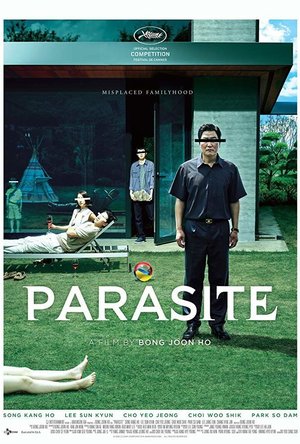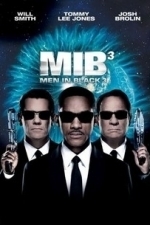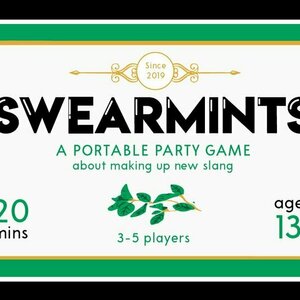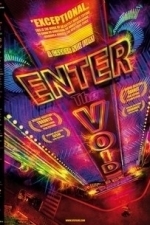Darren (1599 KP) rated Parasite (2019) in Movies
Dec 2, 2019
Story: Parasite starts as we meet the Kim family, all unemployed, with father Ki-taek (Kang Ho), mother Chung-sook (Hye-jin) and adult children, former military service Ki-woo (Woo-sik) and genius computer wizard Ki-jung (So-dam), they take simple jobs like folding pizza boxes, until Ki-woo gets pushed into taking a tutoring job for the Park family, teaching Da-hye (Ji-so) English.
Soon after Ki-woo gets a job for the family, the Park family businessman Dong Ik (Sun-kyun) his wife Yeon-kyo (Yeo-Jeong) fill the roles of their trusted staff with Ki-woo’s family as they get themselves secure well paying jobs, but not everything is as it seems with the house.
Thoughts on Parasite
Characters – Ki-taek Kim is the father of the unemployed family, he has always looked out for his family, while they search for their next meal, once the job opens up for him, he becomes the driver, proving to be a model employee. Ki-woo gets the first job as a tutor for the daughter in the family, he sees this as a chance to get to university, where he makes the plan for the family to get the extra jobs. Ki-jung is the daughter of the family that will become an art therapist for the family, while Chung-sook takes over the house as the maid. This family shows the poverty a family can be experiencing and just how far they would go to try and get out of it. The Park family has businessman Dong-ik who has always been patient with people, letting his wife do the hardest decisions in life, while supporting her always. Yeon-kyo is the wife that deals with the everyday routines in the house, she will do everything she needs to with the people she trusts, even if this does mean she can be taken advantage of.
Performances – We have incredible performances from the whole cast here Song Kang-ho in the leading role shines beyond belief in one of the performances of the year. Lee Sun-kyun and Jo Yeo-jeong give us wonderful supporting roles, with Choi Woo-sik, Park So-dam and Jang Hye-jin shining like the rest of the cast which is flawless throughout the film.
Story – The story here follows a poverty family that luck and con their way into secure jobs for one family, only to see everything spiral out of control in a story that highlights the lines between the rich and poor. This story is one of the most fascinating ones of the year, it does seem like it is going to be a simple enough story, but when everything goes out of control we get to see threads of the story unravel in every directions, see the highlights placed on the rich and poor divide, slowly chipping away at the poorer side of the family, as well as having the other incident going on (which does include too bigger spoilers). Much like ‘Shoplifters’ we see just how hopeless people can feel when they have no realistic future because money they can’t earn can’t give them an out. This is a perfect highlight of how to bring an original story to life, where the audience will be left to ponder what will happen next.
Comedy – The film is set up like a comedy which at times does work, with just how crazy certain moments are, though it doesn’t fall into a laugh out loud comedy.
Settings – The film uses the settings excellently, with the poverty sized house the family can barely not have some drunk piss on the window, to the wealthy businessman who has earnt his way to the top, the difference in lifestyle is drastic with the locations almost being a character of their own.
Scene of the Movie – Party time.
That Moment That Annoyed Me – Nothing.
Final Thoughts – This is one of the most amazing films you will see this year, it will shock you and give us an important message about the clash system in the world.
Overall: Essential Movie.
Gareth von Kallenbach (980 KP) rated Men in Black III (2012) in Movies
Aug 7, 2019
Men In Black 3 features a time travel plot, with a comedic twist, that focuses on the relationship between Agent J, and surly old character, Agent K. Will Smith and Tommy Lee Jones have fantastic and seamless chemistry that makes it easy to dispel disbelief and emerse yourself into this secret world of aliens among us.
The film starts off with what seams like a casual conversation, between wise cracking charismatic Agent J and always grumpy Agent K, but soon leads to Agent K stonewalling J’s questions about K’s past by stating, “Don’t ask questions you don’t want to know the answers to.” As Will Smith’s character persists, our curiosity grows, and a conspiracy of a cover up and clues to Agent K’s dark past unfolds.
Meanwhile, one of the most feared criminals in the galaxy, Boris the Animal (Jemaine Clement), has just escaped from a maximum security prison that was built on the moon to detain him. Boris wants nothing more than to seek revenge on the person responsible for his 40 year incarceration and kill the man responsible for the loss of his arm, Agent K. Through a murderous rage Boris secures a time travel device and jumps back in time to 1969, where he rewrites history by killing K in hopes that his Boglodite alien kind will fulfill their mission to use and destroy present day Earth. The only person aware that time has been altered is, of course, Agent J who ends up traveling back in time to stop Boris the Animal. In doing so, Agent J unites with the younger Agent K (Josh Brolin) and has to work together to ultimately save mankind. Josh Brolin’s performance was spot on. He gave an uncanny impression of Jones, right down to the mannerisms and facial expressions. He was very entertaining to watch.
When I first heard about a third Men in Black movie, I didn’t expect much out of this 10 year dormant franchise. Mainly because the second movie left so little to be desired, due to its horrible storyline and less than stellar performances by the lead characters. I honestly cannot remember a single enjoyable moment from Men in Black 2, someone must have neuralized me!
Barry Sonnenfeld is back in the director’s seat, hoping to redeem himself from the disaster that was Men in Black 2. He attempts to return to the original formula that made the first Men in Black movie fun, original and entertaining. Proving to have succeeded in creating a more worthwhile storyline, there are however moments within the movie that seem a bit thrown together, times in the plot that could have been expanded upon but may have ended up on the editing room floor.
Kudos to the special effects and art direction team for once again creating amusingly and outlandish aliens that were the real stars of the show. The special effects, such as Boris’ dart spitting spider-like creature that lives inside his hand, were particularly gruesome.
Both Sonnenfeld and Smith, who serve as producers, were aiming at providing more substance to the third installment. They wanted to delve into the relationship between J and K and why K has such a bitter and distant persona, especially after having been partners for 15 years. The real reasons will shock you. I won’t spoil the surprising end, but it was a touching twist that I did not see coming. It made me appreciate both characters and had me walking out of the theater feeling pumped up from all of the action, giddy from all of the laughs and moved from the heartfelt ending. They pulled it off without being sappy, a well rounded action comedy, suitable for the whole family.

Your Colour App
Shopping and Lifestyle
App
Do you have clothes in your wardrobe that you never wear? Do you waste money on clothes that...

Inner Perspectives: Guideposts for the Spiritual Journey
Podcast
Elizabeth Clare Prophet, modern mystic and pioneer in New Age spirituality, answers more than 300...

Sweet Baby Girl First Love - Super Cute First Date
Games and Education
App
Sweet Baby Girl Katie is in love for the first time! So sweet and cute! Help Katie invite Justin on...

Power Girls Super City – Superhero House & Monster Rescue
Games and Education
App
- NEW Power Girls’ adventures inside: Ice Monster and superhero makeup! - To the rescue: help the...
Purple Phoenix Games (2266 KP) rated Swearmints in Tabletop Games
Feb 5, 2021
Swearmints is a small card game of voting for the best explanations of silly combination new-slang. The gameplay is familiar but the hilarity is all new.
DISCLAIMER: We were provided a prototype copy of this game for the purposes of this review. These are preview copy components, and I do not know for sure if the final components will be any different from these shown. You are invited to download the rulebook, back the game through the Kickstarter campaign launching March 9, 2021, or through any retailers stocking it after fulfillment. -T
To setup choose a Mint Master (the first dealer) and give them the mint tin with the mint cubes inside. Shuffle the cards to create a draw pile. The Mint Master will then deal each player two cards and the game may begin!
During a round each player will consult their two cards, choosing a word from each, and combining the words to make a new phrase. The cards have four words printed on each side so players will have access to 16 total words. Once all players have chosen their new term they will go around the table introducing and explaining their new slang term to the Mint Master. As all players have finished the Mint Master will choose their favorite new term by awarding one mint cube to the winning player. Players may also earn bonus mint cubes for using two alliterative words, and another mint cube for using two rhyming words. A new Mint Master is then crowned around the table and they thusly deal two cards to the players to begin a new round.
Play continues in this fashion until the tin runs out of mint cubes. The player with the most mint cubes is the winner!
Components. This game is a bunch of cards and green translucent cubes in a mint tin. The cards are fine and double-sided. The cubes are also fine. There is no art to speak of in the game, and no theme. So from me, even if this were the final version (which again, I am not sure) the components are all fine and no complaints from me.
The game is obviously a new variation of the Apples to Apples mechanic where one player is the judge and awards the winner with their opinions. This is tried and true and works for so many games. I feel it also works here. This is not at all a difficult game to learn, teach, or play. In fact, I played a very G-rated game of it with my 4-year-old son and he absolutely loved it. Of course, I had to choose appropriate words for him to use, but he technically played the game and played it well.
Swearmints is a small game that can easily fit in a pocket or backpack and be enjoyed by almost all people in all scenarios. Need something to play with Gramps and Grammie over the weekend? Swearmints. Need something to warmup game night with new players to open them up some? Swearmints. Need an icebreaker at work (once work resumes in-person)? Swearmints. There are so many scenarios I can see this being very successful to have on hand and it can be played very innocently or very inappropriately, depending on present company. That’s what makes this a great new spin on the A2A gameplay: its adaptability and portability.
If you are like me, you could always use a little package of excitement in your pocket. Wait. I mean, you could appreciate toting around a small and unassuming little game that can fit many gaming opportunities as they arise. Should you be looking for that little firecracker, then consider backing Swearmints on Kickstarter when the campaign launches in March. You never know when you might need to break it out to ease the tension in the room or to initiate a muggle into the gaming world.
Brian Eno recommended Early Works by Steve Reich in Music (curated)
Andy K (10823 KP) rated Enter the Void (Soudain le vide) (2010) in Movies
Oct 13, 2019
From the psychedelic opening credits (which are the complete film credits by the way, meaning no end credits at all) this film grabs your attention and should immediately realize what you are about to watch is going to be different, exciting, revolting and most of all unique in every way from most movies you have seen in your life until now.
The film focuses on the relationship between Oscar and Linda, a brother and sister living in Japan when tragedy strikes. Oscar goes to meet a friend for a drug deal only to have something go very wrong. For some reason, the police are present and pursue Oscar to the bathroom where he tries to dispense the drugs eliminating the evidence down the facilities. Shortly after, Oscar is shot in the chest and dies on the bathroom floor.
It seems as if Oscar's "soul" leaves his body and begins a hallucinatory journey interacting with his former friends, acquaintances and sister in a spiritual and mind blowing way to help make him and the audience understand the events which led to his death.
The siblings have had a rough life including the horrible death of their parents in an automobile accident when they were young. They were in the back seat as well, so not only witnessed the physical and emotional trauma, but also had to endure the subsequent separation from each other through foster care having to grow up without each other. Before they were separated, they made a blood pact and said they would always be there for each other no matter what.
Linda works at a dance/strip club and the forlorn about the death of her brother, but continues her job duties including dancing and having sex. She gets pregnant, then deals with the repercussions of the act. She becomes increasingly despondent with her life and wishes her brother was still with her.
Oscar's spirit meanders through the lives of his former life watching and understanding the emotions of those left on Earth.
The film is hard to explain and therefore maybe hard to understand as well. This seems to be one of those movies that is not only the words that are spoken, but the emotions that are portrayed and not said aloud. Whatever you believe spiritually about the soul and reincarnation, this film is not here to change your religious beliefs. It is shown in "first person" most of the time, so you interact with the characters of Oscar's life just as he is.
The use of neon colors both on the exterior cityscape of Japan and interior shots o the dance club are gorgeous and reminded me of what the world would appear as if life used a blacklight. The sequences of drug use could not be described as anything else other than living artwork. The rainbow kaleidoscope of the "trip" were reminiscent of "2001: A Space Odyssey" and I read afterwards which is where Noe drew some of his inspiration.
Undoubtedly, the multitude of graphic sex scenes and shocking imagery will turn many off as some of it is pretty extreme, but I feel suits this film symbiotically and perfectly. In fact, the second half of the film is more style than substance (which you could probably say for a lot of Noe's films), but somehow you don't mind since you are along for the ride and enjoy the spectacle anyways.
After reading about the film after my viewing, I discovered there is a "director's cut" including around 20 minutes of additional scenes bring the running time to over 2 1/2 hours.
It looks like I'll be getting the Blu-Ray and watching again in a few weeks!

Video Edit
Photo & Video and Entertainment
App
Video Edit is the FASTEST way to edit and render videos on the iPhone, iPod Touch and iPad. Now...




